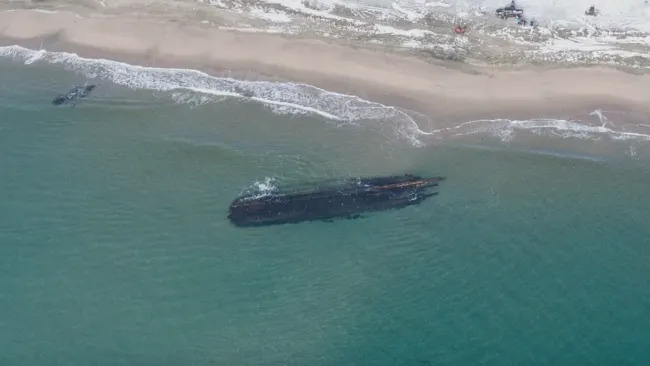Nadine Yousif & Eloise Alanna - BBC News, Toronto
Fri, February 2, 2024
The British Broadcasting Corporation
A mysterious shipwreck that washed up on shore in Newfoundland, Canada, has captured the imagination of locals.
Wanda Blackmore said her son was out sea duck hunting when he stumbled upon the 24-metre long, wooden ship that likely dates back to the 19th Century.
"On his way home, he saw a dark object out in the water," she said.
Locals think the wreck could be a vital piece of Newfoundland history, and experts now intend to uncover what it was before it met its watery grave.
"It could be the ship that brought my ancestors, or my husband's ancestors," said Ms Blackmore, who has English, Irish and Scottish roots.
A team of archaeologists will survey the wreck on Saturday to gather clues on when this particular ship may have been built and why.
The team has to work quickly, as there are fears that strong waves could pull the ship away from the coast and towards deeper waters. They also have to get out there while the tide is still low.
Their process involves measuring the timbers to estimate its original size, as well as trying to determine the age of the trees used to build it, said Neil Burgess, president of the Shipwreck Preservation Society of Newfoundland and Labrador.
"I am hoping we'll be able to figure out more and more of the story, and to be able to piece together where this ship came from and how it ended up here, " Mr Burgess said.
It is familiar work, however, for this team of experts.
Jamie Brake, Newfoundland's provincial archaeologist, said the island has seen countless shipwrecks over the years.
"We live on an island that has a major seafaring history," Mr Brake said.
The wreck appeared on the shores of the small coastal town of Cape Ray on the south-west coast of the island of Newfoundland. Only about 250 people live in Cape Ray, which looks over a rugged part of the Atlantic, with large, shallow rocks that have destroyed dozens of ships since the 1800s.

A team of experts have been surveying the ship's wreckage in hopes of uncovering clues about its origin
Some believe that powerful Hurricane Fiona, which in September 2022 travelled north from the Caribbean and through the Atlantic Ocean before hitting Canada, may have helped dislodge the ship from the ocean floor.
It is the many unknowns around the ship, however, that have captured the province's imagination and caused many to regularly travel to the site to take pictures with the wreck.
Bert Osmond lives in the area and told the Canadian Press that he visits the ship regularly to make sure it has not been washed away by the powerful tide.
"A lot of people's concern is we don't want it to go back out to sea," he told the Canadian news outlet. "If it goes back out to sea, we're not going to know nothing."
That thirst for information has driven many to connect the ships origins to their own, with some wondering if it may have been carrying immigrants from Great Britain or Ireland over to Canada.
Ms Blackmore said many of the residents in Cape Ray can trace back their ancestors' roots in the area to as early as the 18th Century.
The vast majority of Newfoundlanders and Labradorians - about 90% - are descendants of people who came from the British Isles between the early 17th century and the late 19th century.
This resettling was rooted in a seasonal, trans-Atlantic migratory cod fishing tradition that lasted for centuries.
Mr Osmond said that seafaring history means that many in the region feel a special connection to the ship and the history it may hold.
"I was amazed with her, and I still am," he said.
Piece of history from 1800s discovered on Canadian beach
Brian Lada
Thu, February 1, 2024

The remnants of a shipwreck that were discovered near Cape Ray, Canada, in January. (Corey Purchase NiCor Photos via Storyful)
A piece of history has been found along the coast of Canada: the remnants of a shipwreck dating back more than 100 years.
The shipwreck was found near Cape Ray, Canada, located on the southwestern tip of Newfoundland and Labrador.
Experts believe that the ship was dislodged from its resting place on the bottom of the ocean in 2022 during Tropical Rainstorm Fiona, which was the "most intense storm on record" to slam Atlantic Canada. Currents and coastal erosion since the storm have gradually pushed the shipwreck to the coastline.
Based on the construction and shape of the ship, experts believe that it dates back to the 1800s, but the exact name of the vessel and the date it sank are still a mystery.
This is just one of many shipwrecks that have washed up in recent weeks on a coast in North America. In January, another shipwreck was unearthed along the coast of Oregon, the remnants of a boat that dates back to 1929.
Bones found on beach in Canada may be linked to 1800s shipwreck
Stephen Smith
Fri, February 2, 2024
Human remains recently discovered on a beach in Canada may be connected to a shipwreck from the 19th century, police said this week.
The exposed remains were found on a cliff in western Prince Edward Island this past weekend, according to the Royal Mounted Canadian Police. The bones were located in West Cape on Saturday in an area where human remains have been discovered before, authorities said.
"Police are investigating, and have not ruled out that the remains could be connected to a historical shipwreck burial, " RMCP said in a statement.
The coroner's office was also called to the scene and is investigating.
Human remains were also found in West Cape in the 1950s and 1960s, RMCP Cpl. Gavin Moore said, according to the Canadian Broadcasting Corporation.
"Those human remains were of course a separate investigation [but] very similar to this one," Moore said. "As it was reported at that time, it was believed that it was possibly connected to a shipwreck from the 1800s."
Officials did not specify which shipwreck the human remains could potentially be from.
Local resident Rodney Wood told CBC that his father found remains in the area several times over decades.
"We didn't even know it was a burial site until they first showed up, according to my father," Wood said. "He said it was about 1950."
While visiting the area with a CBC TV crew on Tuesday, Wood spotted another apparent bone exposed on the beach, which was also reported to police.

A map of Prince Edward Island, Canada. Human remains were found on a beach in West Cape in the western part of the province this past weekend, according to the Royal Mounted Canadian Police. / Credit: Encyclopaedia Britannica/UIG Via Getty Images
Paul Wood, who lives just yards away from where the bones were found this week, told CBC that he expects more human remains will be discovered.
"I just think there's probably more bones to be revealed yet, as erosion occurs," he said. "I'm sure there will be more bodies discovered, I guess."
Human remains from centuries-old shipwrecks have washed up on Canada's shores before. In 2019, the BBC reported that scientists confirmed that human remains of 21 individuals that were unearthed in Gaspé, Quebec were from an 1847 shipwreck. That ship left Ireland and sank off the coast of Cap-des-Rosiers in Gaspé, killing as many as 150 people, the BBC reported




















